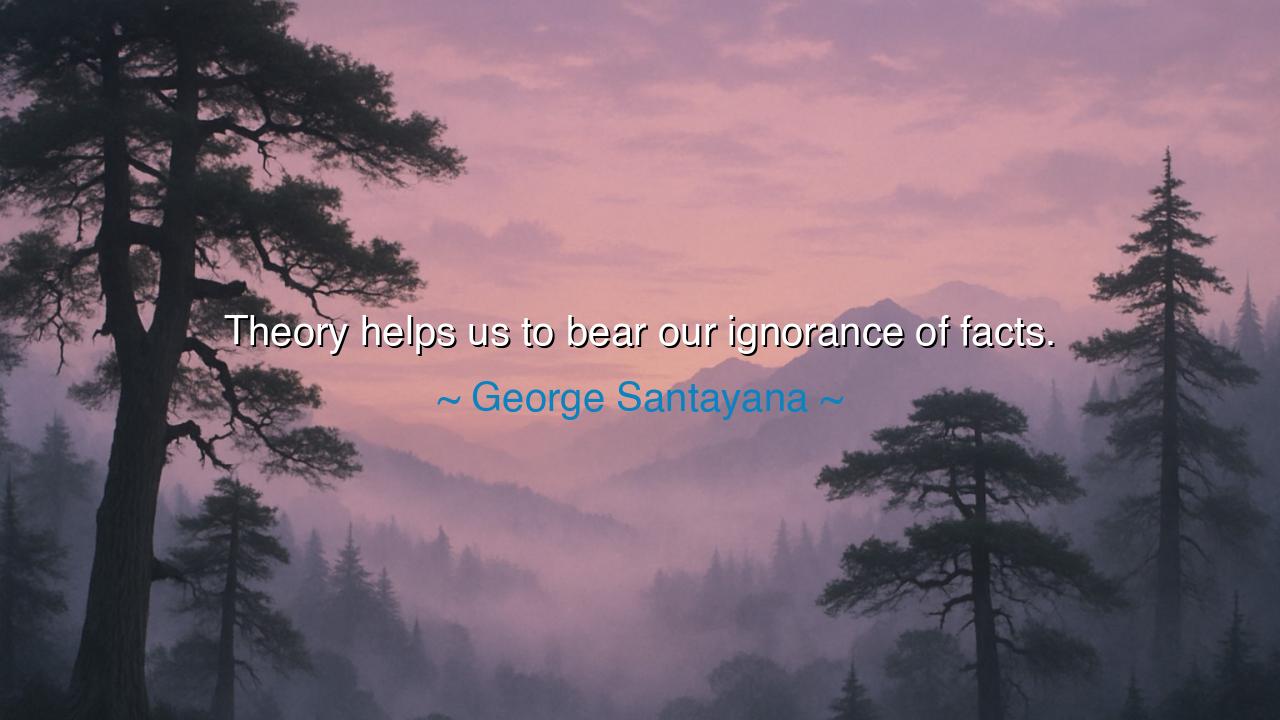
Theory helps us to bear our ignorance of facts.






George Santayana, philosopher and poet of wisdom, once proclaimed: “Theory helps us to bear our ignorance of facts.” These words, though simple, shine like a lantern in the cavern of uncertainty. For man is ever surrounded by mysteries greater than himself. The heavens stretch beyond his sight, the depths of the earth conceal their secrets, and even the chambers of his own heart are not fully known. In this vast ocean of the unknown, theory becomes the vessel by which we sail. It is not truth itself, but a guiding star, helping us endure the weight of what we do not yet understand.
The ancients knew this well. The earliest philosophers gazed upon the cosmos and crafted theories—that the world was made of water, of fire, of atoms, of harmony and number. They did not possess the facts that later centuries would uncover, but their theories gave shape to the unknown, offering courage against the abyss of ignorance. To live without theory is to wander blind, but to live with theory is to walk with a torch, even if the torch does not yet reveal every corner of the cave.
Consider the story of Democritus, who in the days of Greece long before microscopes, conceived of the atom. He did not have the facts to prove its existence, yet his theory gave man a way to imagine the hidden structure of matter. Centuries later, with the rise of science, this vision was confirmed in ways Democritus could scarcely have dreamed. His theory did not erase ignorance, but it bore its weight, giving meaning until the facts could finally arrive.
So too in the realm of the stars. Before the telescope, Ptolemy’s theory of a geocentric universe gave order to the wandering lights of the sky. Though false, it helped generations of scholars bear their ignorance of celestial truth. And when Copernicus and Galileo replaced it with the heliocentric vision, mankind moved closer to reality. Thus, theory is not a lie, but a bridge—sometimes weak, sometimes strong—between the darkness of ignorance and the light of fact.
Santayana’s wisdom also speaks to the soul, not only to the sciences. For in our daily lives, when facts are hidden from us—when the future is uncertain, when motives of others are unclear, when destiny itself is veiled—we build theories to comfort and guide us. We imagine causes, we propose meanings, we fashion stories that help us endure the unknown. These theories may not always be right, but they steady the heart until truth reveals itself. Without them, ignorance would crush us; with them, we find the strength to keep walking.
But we must also beware. For if we cling too tightly to theory, forgetting that it is but a temporary raft, we risk mistaking it for truth itself. History is filled with those who worshipped their theories, rejecting new facts that shattered them. The wise man holds theory with humility, knowing it is a servant, not a master. He welcomes the arrival of new facts, even when they break the old frame. For progress is born not in clinging to theory, but in letting it yield to the truth when the time comes.
So I say unto you, seekers of light: let theory be your companion, not your idol. Use it to bear the burden of what you do not yet know, but hold it with a heart open to change. Do not fear ignorance, for it is the space into which knowledge will grow. And remember Santayana’s teaching: theory is a tool to endure the unknown, but it is the facts that set us free. Therefore, build your theories with courage, test them with humility, and let them fall away with grace when truth emerges. In this way, you walk not in despair before ignorance, but in hope, ever drawing nearer to the light.






AAdministratorAdministrator
Welcome, honored guests. Please leave a comment, we will respond soon